Porsche Macan review: the electric car for keen drivers
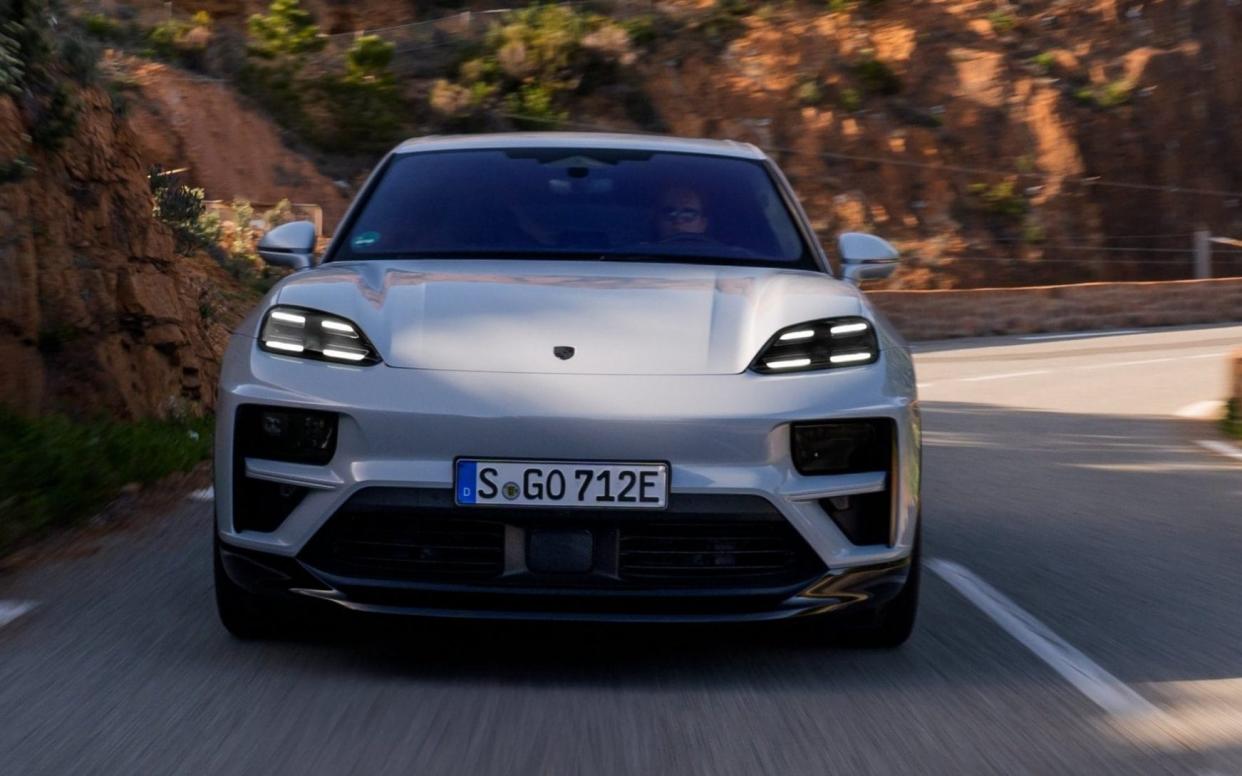
Wherever you care to look, governments, institutions and car makers are backing out of ambitious zero or low-carbon commitments because they find them too expensive, not popular and not very practical. Not least Porsche, which at one time was saying that this new Macan Electric Vehicle (EV) would replace all the combustion-engined examples of its family SUV, which since its launch in 2014 has sold more than 850,000 units, with a high proportion of young women among those buyers.
Then came the volte face. Around the time of the combustion Macan’s mid-cycle facelift in 2020, Porsche realised it was in danger of running out of EV early adopters, that rivals were beginning to hedge their EV bets and that it could be left out in the cold as one of the few sole EV suppliers in one of the world’s biggest and fastest growing markets. Tesla might manage to shift huge amounts of its Model Y, but legacy car makers aren’t quite so convinced as to completely disband their petrol SUVs just yet.
So, the facelifted combustion Macan would continue to be sold, even in the UK. Although not in the EU, where it has been the victim not of environmental legislation but of cyber security demands in the EU’s General Safety requirement, which comes into force this July. The electronic architecture in the combustion Macan simply won’t pass the test.
And how long will you still be able to buy a Macan with pistons? Some pundits are quoting the end of 2025, others three years after the start of sales of this Macan EV, which is already a year late because of software issues at Volkswagen (the Macan EV is based on Audi’s Q6 e-tron body). So petrol Macans could be on sale until 2027.
EV on sale now
Nevertheless, the current Macan EV is going ahead, on sale now, for first deliveries this autumn. It’s priced from £69,800 for the 381bhp/479lb ft Macan 4 with a 367-mile official WLTP range. With the overboost function, which also includes launch control, that power is extended to 402bhp and the top speed is 137mph and 0-62mph in 5.2sec
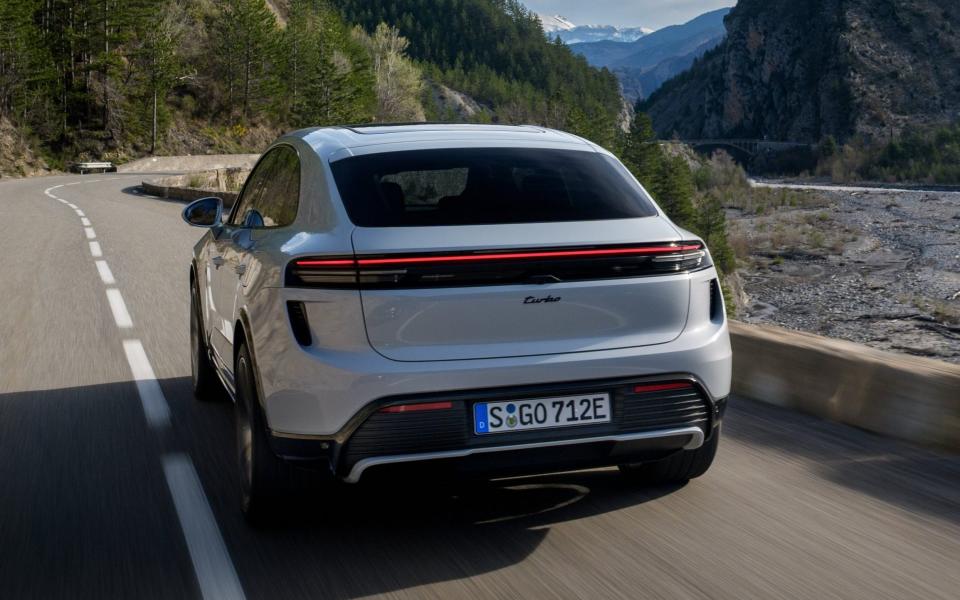
The £95,000 top-model Turbo delivers 576bhp/833lb ft (630bhp on overboost) and has a 381-mile range, a top speed of 162mph and 0-62mph acceleration in 3.3sec. Combustion-engined Macans, meanwhile, start at £54,900. In case you were wondering, there’s no turbocharger on an EV, Porsche is simply using the nomenclature of some of its famed petrol-powered sports cars.
At the heart of the drivetrain is a 100kWh (95kWh useable) lithium-ion NMC battery in the floor, with independent wishbone suspension front and rear. It will charge at up to 270kW DC if you can find a suitable charger; a 10 to 80 per cent fill can be achieved in 21 minutes.
The Turbo has air suspension and active damping as standard (optional on the Macan 4). It’s also the first Macan to be offered with rear-wheel steering, which hydraulically jacks the rear wheels against their suspension bushes to give up to 5 degrees of turn at low speeds (to aid manoeuvrability) and less than a degree at faster speeds (to aid stability). It has the effect of virtually decreasing the wheelbase at low speeds and increasing it at high speeds.
Clever stuff
There’s also the usual litany of clever Porsche engineering including its torque vectoring system on the Turbo model, s system that electronically manages how the power is distributed to each wheel. There’s also Porsche Active Suspension Management, which adjusts the suspension rate and damping in tiny measured amounts, along with twin valve damping that separately adjusts the bounce and the rebound.
The battery-electric model is a bit larger than the combustion Macan but its style is very similar. Chunky and waisted, it has frameless doors, a flat bonnet, distinctive LED headlights and “socket” air intakes on the lower valance. Aerodynamic tweaks including active cooling shutters, wheel design and a flat floor means the coefficient of drag has dropped from the combustion Macan’s 0.35Cd to only 0.25Cd, which equates to a range benefit of 53 miles.
The Macan EV is 4,784mm long, 1,938mm wide (2,152mm with the mirrors), 1,622mm high and has a 2,893mm wheelbase, which is 86mm longer than the combustion Macan. It weighs 2.330 tonnes and will tow up to 2 tonnes. The powered boot lid reveals a 540-litre space, which extends to 1,348 litres if you fold the rear seats, which are split 40/20/40. It’s available on 20, 21 and 22in wheels and tyres.
Step inside
The interior is a case study in understated Porsche quality, with the touchscreen set into the facia rather than being the usual “iPad jammed into the dash” style of the opposition. Instead, you get that weird and inscrutable Porsche stopwatch in the centre of the dash as though you were just about to post a lap time at the Nürburgring circuit when in reality you are on your way to Waitrose.
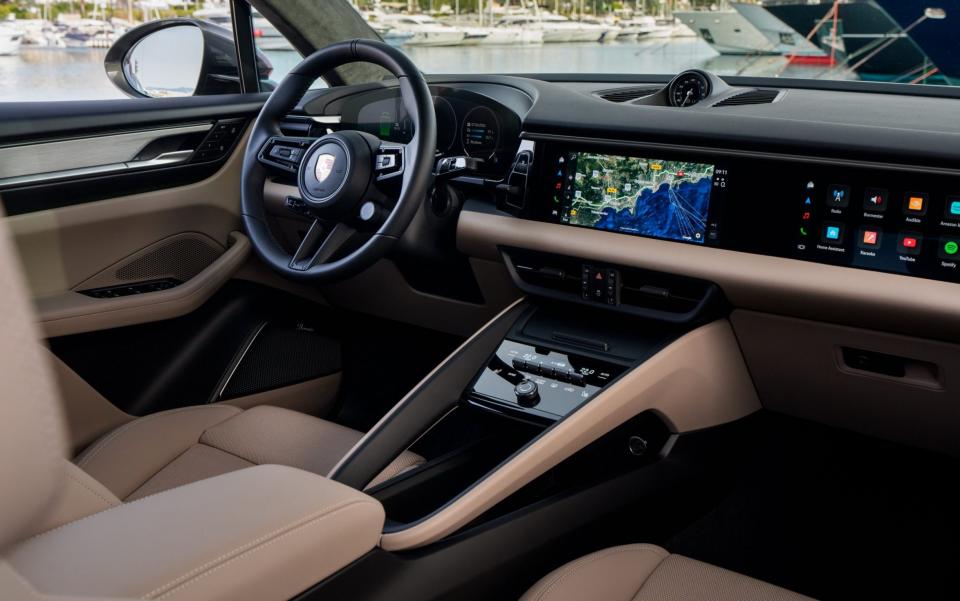
The three-dial digital instrument binnacle is clear and there’s a head-up display that can provide speed, satnav directions and battery state of charge. It’s all rather lovely, but it does require learning, with some difficult and complicated sub-menus to get what you want on the displays. The satnav will consider traffic conditions and topography to get you to the next charging station and you can select how much charge you’d like in the cells when you get there.
The seats are comfortable and supportive, although you can obviously buy more supportive and racier versions at a cost. In the back there’s head and leg room to spare for the 6ft-tall me to sit behind myself in comfort and the boot has a false floor to provide a large hidden storage area for charging cables and the like.
While the price seems dear, the options list seems like daylight robbery. Our Macan 4 test car started at £69,800, but by the time it had been sprayed with Papaya Metallic paint (£1,185) and fitted with 14-way comfort seats with a memory package, heating and ventilation (£899 + £324 = £704), Isofix childseat mountings on the passenger seat (£140) and air suspension, along with a host of other options, it was £94,522.
Likewise, the Turbo model starts at £95,000 but provides a much higher equipment level including the air suspension, although our test car had £15,828 of options taking the retail price to £110,828.
Hit the road
On the road out of Antibes in the south of France, the Macan 4 felt pregnant with unused potential; a bit stiff, but with decent control progression and good visibility from the driver’s seat. The undemonstrative facia is pleasingly free of gimmicks, but not the steering wheel which is covered in buttons so it’s easy to inadvertently change the display or the radio channel when you turn a tight corner.
Some might find the low seating position not to their liking, although the seats do power up and down. With all the cars on the optional air suspension there’s an element of low-speed fizz to the ride and certainly the 20in wheels (the standard wheel and tyre size) tell you all about the road surface in town.
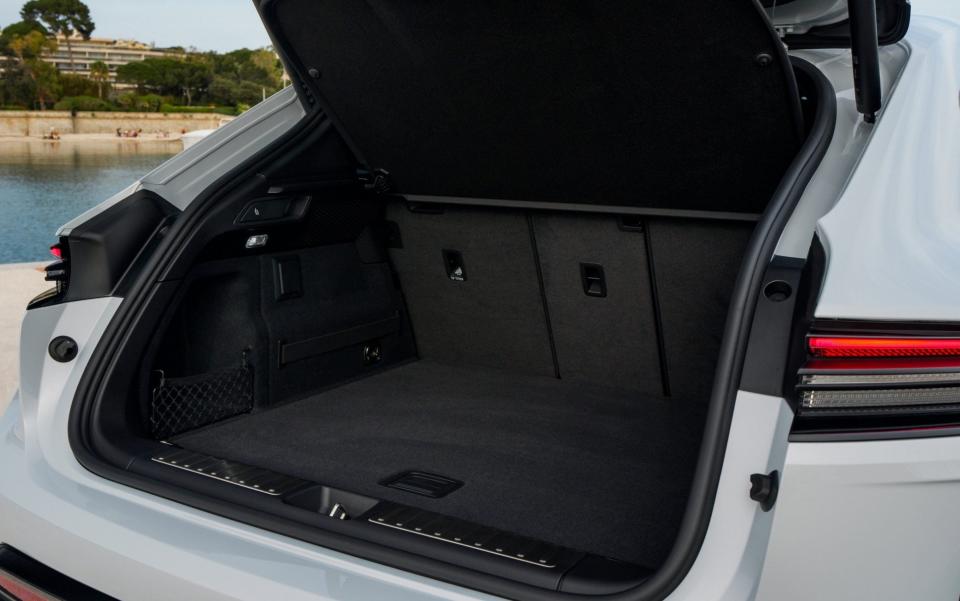
Up in the Alpes-Maritimes mountains, however, something remarkable happens. The progressive power delivery encourages you to push a bit harder and the steering, so well weighted, doesn’t say no. There’s a bit too much body movement in Normal mode, so you switch to the first level of Sport on the steering wheel-mounted rotary control. The air suspension sharpens its watch on the dampers and body control picks up the drift.
By now you’re travelling quite briskly into an open corner where most rival SUVs of this size feel big, unwieldy and uncommunicative. You turn these cars in on trust rather than feel or instinct.
But blow me down, the Macan’s steering is not only precise, with a first rate on-centre response – it also imparts a degree of feedback to the rim. All round, this version of the Macan feels agile and wieldy and the way it shrinks around the driver is pretty remarkable considering its size and weight.
“We spent a lot of time on the steering,” says Robert Meier, the electric Macan’s head of development. “It’s an all-new system and is one of the differences between our car and the Audi Q6.”
Time for the Turbo
The top model features all the bells and whistles including rear steering and a lot more power and torque. On 22in Goodyear tyres, the ride is a lot worse than on the 20in items of the Macan 4. The wheels clunk and crash through town and it tramlines along the edges of road repairs.
Farther up in the mountains, you’ve got to admire the extra power and torque, but also learn not to overdrive it and ease the nose through bends to maintain stability. But that rear steering really gets in the way and there are times when the rear wheels seem to be reacting to bits of road that the front wheels never saw. I lost a bit of confidence in the rear, which jangled around and never felt fully planted. In addition, the torque vectoring didn’t do much for me on the undulating, high-friction roads of the famed Route Napoléon. Certainly, you travel faster in the Turbo, but the penalty is the lack of communication and fluency.
Meier conceded that perhaps the Macan 4 is the sweeter chassis, especially on the smaller wheels and tyres, but Porsche owners will drive harder, especially in Germany where the roads are smoother than even those of the Alpes-Maritimes. The Turbo, with its stiffer body control and high-tech dynamics, is the bruiser they want for those high velocities. And in those circumstances, the rear steering and torque vectoring will keep you safe and planted.
Whichever you choose, the brakes are quite brilliant, with a sensitive pedal and a confidence-inspiring grab at the top of its travel. There are no gimmicks, no one-pedal operation, no steering-wheel paddles to increase the regeneration effect, as Porsche thinks these common EV additions get in the way of driving purity and have a negligible effect on the amount of recovered electricity.
The Telegraph verdict
Apart from the dubious marketing strategy of selling similar looking and sized cars with different chassis and drivelines but with the same name (apparently E-Macan was rejected), the Macan stands alone in its responsiveness and, in the cheaper Macan 4, the sheer pleasure of driving it. But it’s a family SUV that weighs 2.3 tonnes, for Pete’s sake, it does 137mph and 0-62mph in a scorching 5.2sec and against a quoted 367-mile range, I only managed 283 miles going up and down to the mountains on a warm sunny day. Moreover, while the tailpipe emissions are zero, if you factor in the electricity used to charge it in the UK, it emits CO2 and equivalent at a rate of 33.2g/km.
And there’s the problem. If you want a Macan, Porsche produces a perfectly adequate one with a piston engine. For some folk lucky enough to run a car through a business, or with a choice of company car, the battery Macan makes sound financial sense and drives supremely well. But for the rest of us who actually buy our cars, the choice is a lot less clear cut.
The facts
On test: Porsche Macan 4 EV
Body style: five-door premium family SUV
On sale: now
How much? from £69,800 (£94,522 as tested)
How fast? 137mph, 0-62mph in 5.2sec
How economical? 2.94-3.47mpkWh (WLTP Combined) (3.0-3.3mpkWh Turbo). On test in both, 2.98m/kWh
Electric powertrain: twin permanent-magnet AC synchronous motors (front 234bhp, rear 375bhp) driving all four wheels via step-down transmissions. High voltage 800-volt operating system. Lithium-ion NMC 811 battery with 100kWh total energy 95kWh useable. 11kW onboard charger and charging up to 100kW with a Type 2/CCS socket
Electric range: 367 miles (283 miles on test)
Maximum power/torque: 402bhp on overboost/479 lb ft
CO2 emissions: 0g/km (tailpipe), 33.2g/km (well-to-wheel)
VED: £0
Warranty: three years unlimited mileage with eight years and 100,000 miles on the battery
The rivals
Audi Q6 e-tron, from £68,975
After the Macan, Audi’s 382 to 510bhp Q6 will be the second showing of VW’s posh electronic architecture known as Premium Platform Electric. The Q6 has a vaunted range of around 381 miles in its top model form, thanks to new cabling, energy-dense batteries and more efficient semiconductors with faster charging and 800-volt operating systems with battery pre-heating and “bank charging”. Blimey, it almost looks like the Macan, too.
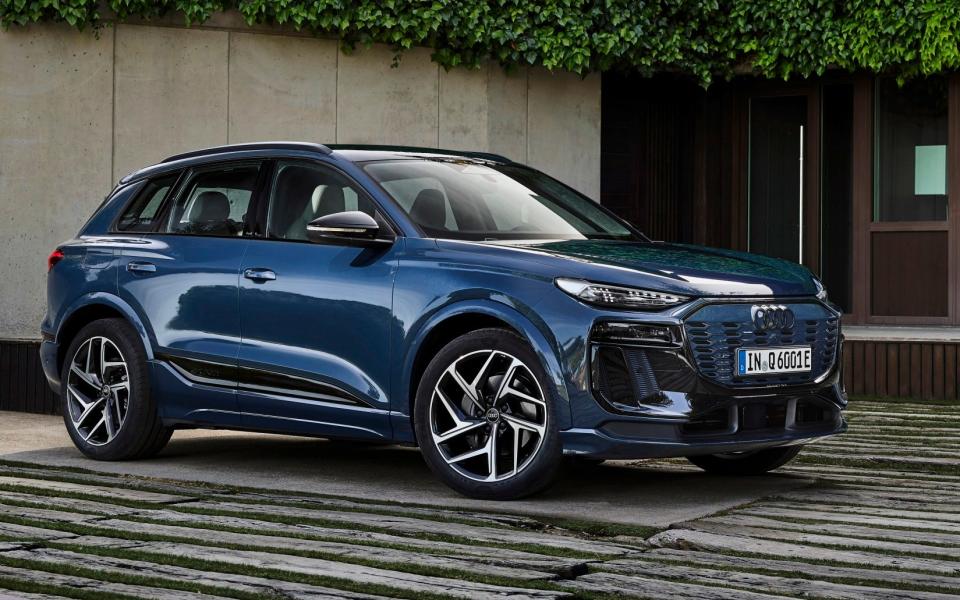
Genesis GV70, from £65,105
At 4,715mm the GV70 is almost as long as the Macan, but built on a multi-power chassis and is basically a big version of the well-received GV60 with a 77.4kWh battery, an overall power output of 429bhp and a 248-mile range. While some folk will like the Genesis promise, which means you might never have to step into a dealer again, this is a big car based on a smaller-car platform, with a less-than-stellar range. The interior is rather good, the ride and handling are passable, but this is an outlier in a very competitive market.
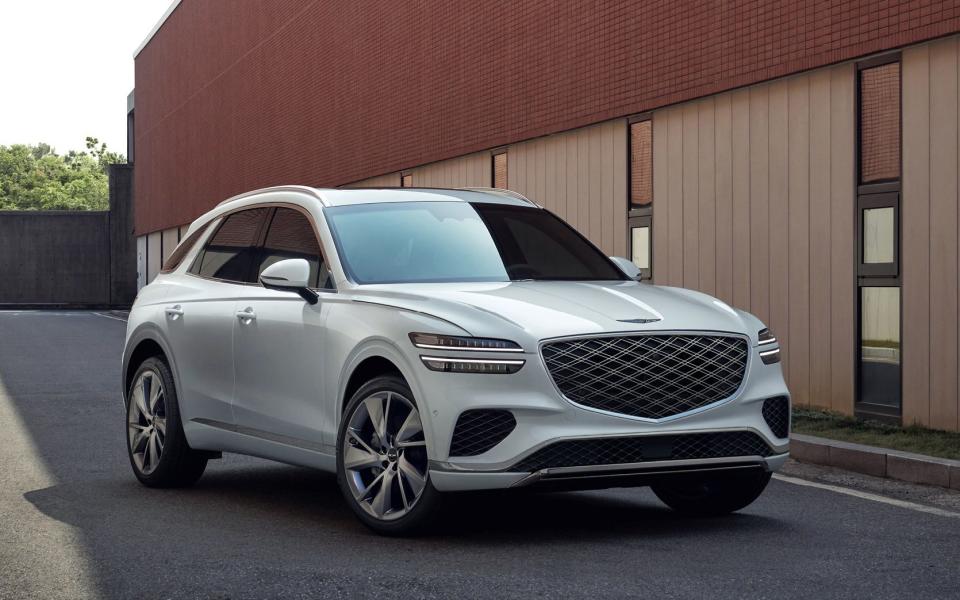
Maserati Grecale Folgore, from £109,900
Looking very like the petrol-engined alternative, the Folgore is Maserati’s first serious step in its transition to full electric power. This 4x4 premium SUV sports a 97kWh hour lithium-ion battery and has a total power output of 550bhp. Top speed is 137mph with 0-62mph in 4.1sec and a range of 311 miles. It’s very expensive, not particularly efficient and will only charge at a maximum of 150kW DC, but it’s fast and certainly luxurious.

